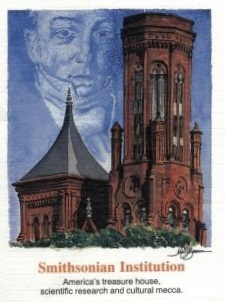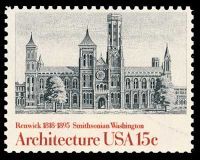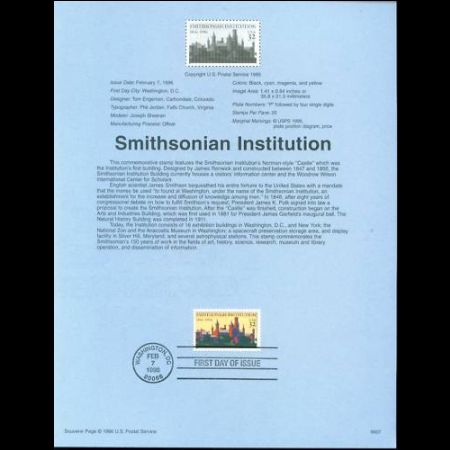USA 1996 "150th anniversary of the founding of the Smithsonian Institution"
| <prev | back to index | next> |
| Issue Date | 02.07.1996 |
| ID | Michel: 2693 Scott: 3059 Stanley Gibbons: 3171 Yvert: 2472 UPU: N/A Category: Ot |
| Author | Tom Engeman |
| Stamps in set | 1 |
| Value | 3c - 150th anniversary of the founding of the Smithsonian Institution |
| Size (width x height) | |
| Layout | 20 stamps per sheet |
| Products | FDC x |
| Paper | |
| Perforation | 11.1x11.1 |
| Print Technique | Lithography, multicolor |
| Printed by | Ashton-Potter (USA) Ltd |
| Quantity | 115,600,000 |
| Issuing Authority | U.S. Postal Service |

The Smithsonian Institution was established with funds from James Smithson (1765-1829), a British scientist who left his estate to the United States to found at Washington, under the name of the Smithsonian Institution, an establishment for the increase and diffusion of knowledge.
Smithson, the illegitimate child of a wealthy Englishman, had traveled much during his life, but had never once set foot on American soil. Why, then, would he decide to give the entirety of his sizable estate which totaled half a million dollars, or 1/66 of the United States entire federal budget at the time to a country that was foreign to him?

US President Andrew Jackson |

US President James K. Polk |
Smithson died in 1829, and six years later, President Andrew Jackson announced the bequest to Congress. On July 1, 1836, Congress accepted the legacy bequeathed to the nation and pledged the faith of the United States to the charitable trust. In September 1838, Smithson's legacy, which amounted to more than 100,000 gold sovereigns, was delivered to the mint at Philadelphia. Recoined in U.S. currency, the gift amounted to more than $500,000.
After eight years of sometimes heated debate, an Act of Congress signed by President James K. Polk on Aug. 10, 1846, established the Smithsonian Institution as a trust to be administered by a Board of Regents and a Secretary of the Smithsonian. Since its founding .more than 164 years ago, the Smithsonian has become the world's largest museum and research complex, with 19 museums, the National Zoo and nine research facilities.

 The National Museum of Natural History (NMNH) is part of the Smithsonian
Institution, the world's preeminent museum and research complex.
The Museum is dedicated to inspiring curiosity, discovery, and
learning about the natural world through its unparalleled research,
collections, exhibitions, and education outreach programs. Opened in
1910, the green-domed museum on the National Mall was among the first
Smithsonian building constructed exclusively to house the national
collections and research facilities. The Smithsonian's
natural history
collections have their origins in the 1838-1842 United
States
Exploring Expedition, which circumnavigated the globe
amassing cultural and natural history collections. Concern over how to
care for the collections led to the provision for a museum as part of
the Smithsonian Institution's enabling act of 1846. In 1858, the US
Congress began to provide appropriations for the United States National
Museum and all the government's collections were transferred to the
Smithsonian Institution. The Smithsonian also received specimens by
gift or purchase in the late 1840s. In 1850, the newly appointed
Assistant Secretary Spencer F. Baird donated his personal natural
history collection to the Institution. During the 1850s and 1860s,
several expeditions which explored the American West, sent additional
specimens to the Institution. The collections were initially housed in
the Institution's first building, the Smithsonian Institution Building,
or Castle, which was completed in 1855.The National
Collections were moved to the newly constructed National Museum
Building, now the Arts and Industries Building, in 1881. But within two
years, the new building was overflowing with collections and
Smithsonian management requested another building from the US Congress.
Legislation for the new building finally passed in 1902, providing for
a granite structure across the National Mall from the Smithsonian
Castle.
The National Museum of Natural History (NMNH) is part of the Smithsonian
Institution, the world's preeminent museum and research complex.
The Museum is dedicated to inspiring curiosity, discovery, and
learning about the natural world through its unparalleled research,
collections, exhibitions, and education outreach programs. Opened in
1910, the green-domed museum on the National Mall was among the first
Smithsonian building constructed exclusively to house the national
collections and research facilities. The Smithsonian's
natural history
collections have their origins in the 1838-1842 United
States
Exploring Expedition, which circumnavigated the globe
amassing cultural and natural history collections. Concern over how to
care for the collections led to the provision for a museum as part of
the Smithsonian Institution's enabling act of 1846. In 1858, the US
Congress began to provide appropriations for the United States National
Museum and all the government's collections were transferred to the
Smithsonian Institution. The Smithsonian also received specimens by
gift or purchase in the late 1840s. In 1850, the newly appointed
Assistant Secretary Spencer F. Baird donated his personal natural
history collection to the Institution. During the 1850s and 1860s,
several expeditions which explored the American West, sent additional
specimens to the Institution. The collections were initially housed in
the Institution's first building, the Smithsonian Institution Building,
or Castle, which was completed in 1855.The National
Collections were moved to the newly constructed National Museum
Building, now the Arts and Industries Building, in 1881. But within two
years, the new building was overflowing with collections and
Smithsonian management requested another building from the US Congress.
Legislation for the new building finally passed in 1902, providing for
a granite structure across the National Mall from the Smithsonian
Castle.
More about History of NMNH
is here
Related stamps
 |
 |
|||
| USA 1946 "100th anniversary of the founding of the Smithsonian Institution" | USA 1980 "American Architecture" |
Products
| FDC | |
 |
 |
| Stamps Sheet | Souvenir Sheet |
 |
 |
References
Smithsonian Institution mysticstamp| <prev | back to index | next> |